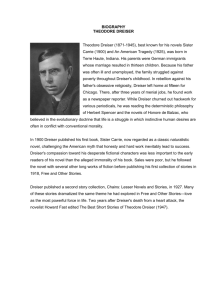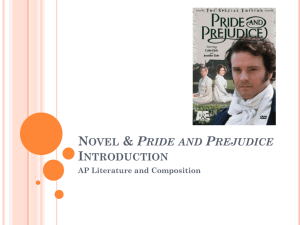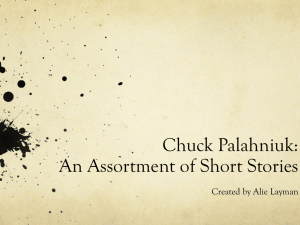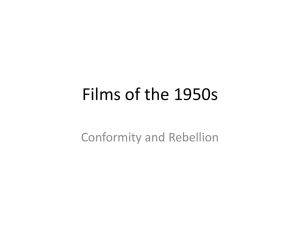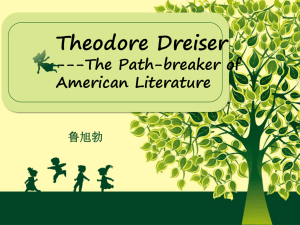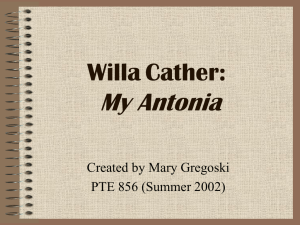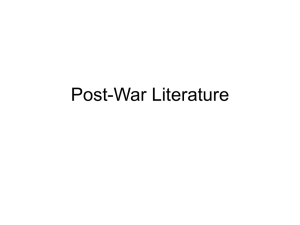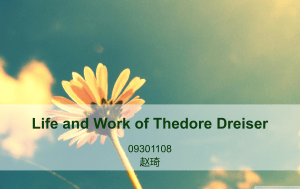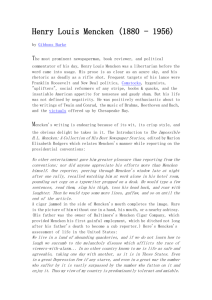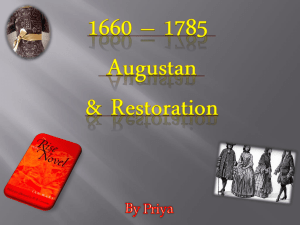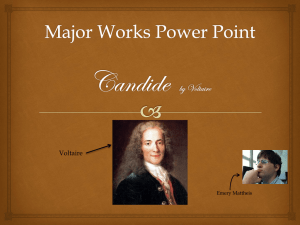Major Works - American Drama
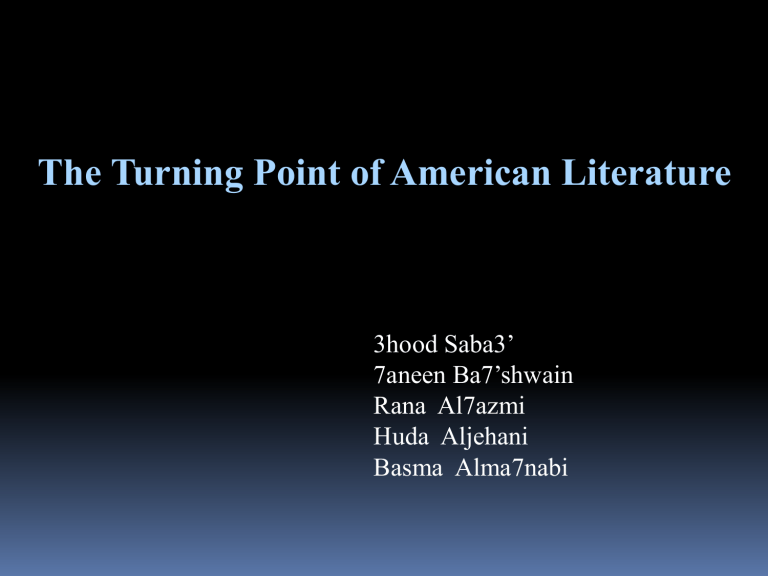
The Turning Point of American Literature
3hood Saba3’
7aneen Ba7’shwain
Rana Al7azmi
Huda Aljehani
Basma Alma7nabi
Social Background of This Period
:
As the new century entered its second decade, the forward movement of American literature seemed to have stopped. The realist novel of W. D. Howells and
Hamlin Garland were beginning to seem old-fashioned.
Among the exciting young writers of the Turn of the
Century, Jack London seemed to have lost his genius and Frank Norris and Stephen Crane were already dead.
People were again asking what was wrong with
American literature?
•
Part of the problem was that most American readers and writers had not yet outgrown the nineteenth century.
•
In the 1840s, Emerson had shown American literature the way forward.
•
In the 1880s, W. D. Howells gave similar leadership to the realist movement.
•
Starting in 1915, the critic Van Wyck Brooks opened a period of self-criticism.
•
Young writers took notice of Brooks’s criticism. The result was the new realism which lasted up to the 1950s.
•
It made American literature one of the most exciting and most influential literatures of the world.
•
With The Flowering of New England: Brook became recognized as America’s first serious literary historian.
•
In a sense, the nineteenth century didn’t end in America until about 1913. Around this time, the new critics- Brooks,
H. L. Mencken and Hanna Larson- began celebrating the death of Puritanism.
•
In the nineteenth century, there was a “double standard” in both public and private morality: people had to “talk one way while acting in a completely different way”. But this was beginning to change. American readers were beginning to lose their fear of those who looked below the surface of human relationships.
• In 1919, Sigmund Freud, the great Austrian psychologist, had given a famous lecture series in
American artists. But even before Freud’s arrival, two
American novelists were starting to destroy the “double standard” of America’s puritanical morality: Edith
Wharton and Theodore Dreiser.
The Major writers
Edith Wharton
Theodore Dreiser
Willa Cather
Ellen Glasgow
Sherwood Anderson
Sinclair Lewis
H. L. Mencken
•
American author best known for her stories and novels about the upperclass society into which she was born
•
Wharton is today recognized as a major writer of the first two decades of the twentieth century.
Edith Wharton
(1862-1937)
•
She has written extensively on New
York families with old money in struggle with social climbers.
Her fiction belongs to the novel of manners tradition.
Her prose is elegant and her plots are tightly constructed.
She is the first woman to receive a Doctor of Letters degree from Yale University
Her major literary model was Henry James, whom she knew, and her work reveals James's concern for artistic form and ethical issues.
In her novels she explored the suffering caused by changing economic forces and Victorian-era social codes
Wharton 's first novel, The Valley of Decision , The
House of Mirth (1905) was a novel of manners that analyzed the stratified society in which she had been reared and its reaction to social change.
she wrote also novels such as The Reef , The Custom of the Country , Madame de Treymes, Ethan Frome
Summer , and The Age of Innocence , which won a
Pulitzer Prize.
The House of Mirth
The House of Mirth is a story of a beautiful but poor woman, Lily Bart, trying to survive in the pitiless New York
City .Lily Bart through society with the aim of finding a suitable and wealthy husband. Unsuccessful in her search, she suffers declining fortunes and is reduced to poverty, excluded from the social circles she once charmed and burdened with financial debts. In the end , Lily experiences a moment of high emotion before realizing the hopelessness of her situation
The Age of Innocence
The Age of Innocence presents a picture of upper-class New York society in the 1870s. In the story,
Newland Archer is engaged to May
Well and, a beautiful but proper fellow member of elite society, but he falls deeply in love with Ellen Olenska, a former member of their circle who has returned to New York to escape her disastrous marriage to a Polish nobleman.
Both lovers prove too obedient to conventional taboos to break with their upper-class social surroundings, however, and Newland feels compelled to renounce Ellen and marry May.
The theme of all Wharton novels about:
Passion ,transgression, the land and the people, isolation, lost potential & poverty
Theodore Dreiser (1871-1945)
•
Novelist Theodore Dreiser was a leading American figure in the literary movement known as naturalism whose novels depict real-life subjects in a harsh light and depicted people as victims of blind forces and their own uncontrolled passions.
•
Dreiser's books were held to be amoral
, and he battled throughout his career against censorship and popular taste
.
•
Dreiser’s first novel, Sister Carrier , was so shocking for its time that the publisher almost refused to publish it.
The book was eventually published, but only in an altered form.
•
Many of Dreiser’s other novels sparked a similar response such as Jennie Gerhardt,The Genius,
An American Tragedy ,The Bulwark
The heron in Sister Carrie ,Carrie Meeber, leaves the poverty of her country home and moves to Chicago. She is completely honest about her desire for a better life clothes, money & social position. Carrie is quite modern in the way she moves from one relationship to another. She tries to be faithful to them , but circumstances make this impossible. By accident, she becomes a success as an actress. In the end, she learns that even money & success are not the keys to true happiness.
Dreiser’s greatest novel, An American Tragedy , the hero (or
“anti-hero”) ,has the same dream as Carrie, he thinks money & success will bring him happiness. When a pregnant girlfriend threatens to destroy
This dream, he plans to kill her. At last moment, he changes his mind
But the girl dies accidently.
Dreiser called his novel a tragedy, its similar to classical
Greek tragedy. It concentrates on a single individual which destroyed by forces which he cannot control.
Willa Cather (1873-1947)
Willa Cather herself was born in the Upper
Shenandoah Valley in western Virginia, near
Winchester, the oldest of seven children of Charles and Virginia Cather. When she was nine, her parents moved west to join her paternal grandparents on the open plains of Nebraska, taking a large and varied household on the grandfather’s farm in the Catherton precinct of Webster County, an area so populated with southernest that its school was called
The New Virginia School. Within two years, however, Charles Cather moved the large household into the town of Red Cloud, where he opened a real estate office. Just as her months in the country had introduced her to the immigrant farmers from Sweden, France, and
Bohemia, in Red Cloud Willa
Cather discovered a cast of smalltown characters rich in cultural diversity.
Major Works
Cather's famous novels O Pioneer ! ,
The song of the lark , and My
Antonia . Each is a successful story .
Also , she wrote “ Alost lady and the professor’s House “ in which she describes the decline and fall of the great pioneer tradition . It is being defeated by the new spirit of commerce and the new kind of man the businessman . Some say that in writing of the past she was trying to escape form the ugliness of the present.
Her famous short story Neighbor Rossick is about the last days of a simple , hard working immigrant farmer.
About The Song of Lark:
The Song of the Lark is the story of an artist's growth and development from childhood to maturity. The
Song of the Lark examines the themes of the artist's relationship with family and society, themes that would dominate all of Cather's best fiction .
.
Ellen Glasgow (1874-1945)
Ellen Glasgow was born in 1874. As a child she watched her gentle mother, a lady of the Virginia aristocracy, declined to nervous invalidism after bearing ten children. As a young woman Ellen
Glasgow refused to attend church with her father, an act of intellectual rebellion. Without much formal schooling she read, on her own, advanced thinkers of the time and was particularly influenced by Social
Darwinism, a philosophy which hardly consoled her.
Ellen Glasgow examined the problem of change. She spent her life writing novels about her states past. She is a rebel against the old traditions of the south . She didn’t direct all her criticism at the men.
In Virginia (1913), best of the earlier novels, the protagonist is a woman, though not a rebel. Blind Mrs.
Blake in The Deliverance (1904) is protected by her family from knowing the Civil War is lost and the slaves freed. In Woman Within (1954), an autobiography written for posthumous publication,
Glasgow tells of a long, secret affair with a married man she had met in New York. The novel of great personal importance to the author was Barren Ground
(1925), in which she felt she had reversed the traditional seduction plot. She thought writing Barren
Ground, a “tragedy,” freed her for the comedies of manners The Stooped to Folly (1929), and The Sheltered
Life (1932) is a novel about the breakdown of the false world of the south. These late works are the most artful criticism of romantic illusion in all her long career.
Ellen Glasgow died in her sleep of a heart attack in
1945
Sherwood Anderson (1876-1941)
ـHe brought the techniques of “modernism” to
American fiction .
-This techniques included a simpler writing style, very much like ordinary spoken English more emphasis on the form of the story than on its content and a special use of time(in which past, present and future are mixed together, as in a dream).
Many younger writer influenced by Anderson modernist ideas (Ernest Hemingway, william
Faulkner,thomas Wolfe ).
Major Works
About Wines burg, Ohio: the book is actually collection of connected short stories .
All of the characters live in the same small town . Almost all of them are lonely people.
They are cut off from other people and cannot . Communicate what is their hearts this loneliness makes them act in strange ways. Anderson s novel marching men poor white dark laughter . The novels seem to be made up of a series little stories rather than being united by one large story his style was much better suited to the short story
Sinclair Lewis (1885-1951)
Lewis’s Main Street (1920) “is the continuation of Main Streets everywhere . The story would be the same in Ohio…or in the hills of Carolina”
This is because Lewis’s real subject is
American culture “ our comfortable tradition and sure faith “
Lewis’s purpose is satire (and sometimes pure comedy ) . His method is kind of
“ photographic realism” . His scenes are usually “catalogs” (lists) of details .
These details create a kind of drama in themselves.
Major Works
Babbitt , Lewis’s next famous novel , is the story of the perfect conformist; a man who tries to act the same way everybody else does .
Like Main Street , the novel is extremely funny satire., sociological study of American business culture .
“Lewis severely condemns the values of middle-class America, but he does not suggest any other values which can take their place . There is no “salvation” (a man who devotes his life to teaching people about religion) , there is no character who is free from evil. No one shows us a different set of values .
Ernest Hemingway was trying to create his own answer to these problem. In Hemingway succeeded in developing his own set of American values . This was something Sinclair
Lewis could never do .
H. L. Mencken (1880-1956)
Henry Louis Mencken, America’s most powerful social and literary critic in the 20 th century, was born in Baltimore, Maryland. He was a reporter or editor for several Baltimore papers, among them Baltimore Morning Herald
In 1903 Mencken published a collection of poems, but he considered George Bernard Shaw:
His Plays (1905) his first real book .
In 1919 he published The American Language , a guide to American expressions and idioms. He also wrote articles for the magazines The Smart Set and The
American Mercury which show his hatred to the middle class.
Mencken's autobiographical trilogy started with Happy Days (1940), and was followed by Newspaper Days (1941), and Heathen Days (1943). Last volume,
My Life as Author and Editor , appeared posthumously in 1993. Mencken suffered in 1949 a stroke which impaired his speech. Mencken died of heart failure on January 29, 1956 in Baltimore.
Major Works
About The American Language :
The American Language was published in 1919 and Mencken attempted to bring together examples of American expressions and idioms. The book grew with each reissue through the years, and in
1945 and 1948 he published substantial supplements. By the time of his death, Mencken was perhaps the leading authority on the language of his country.
There seems, even at this late date, some remote possibility that the revival of conservative thought in America may actually suffice to rescue the original reputation of H.L. Mencken, as a funny and profound critic of democracy, and save him from being remembered as only a cranky (perhaps even racist and anti-Semitic) columnist and the author of a decent early book on linguistics. This is not to diminish in any way the enduring value of The American Language ; it remains eminently readable and retains its significance as an important defense of the distinctiveness and even the superiority of American English to British English.
At the time he wrote, Mr.
Mencken's assertion may have seemed audacious, but now no one would argue with his conclusion.
